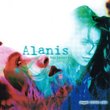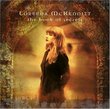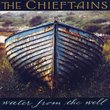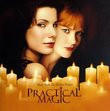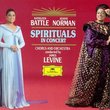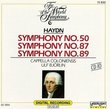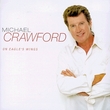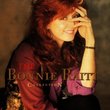| All Artists: George Frideric Handel, Alessandro Scarlatti, Luca Antonio Predieri, Alessandro Stradella, Johann Sebastian Bach, John Nelson, Kathleen Battle, Wynton Marsalis, Orchestra of St. Lukes, Anthony Newman, John T. Kulowitsch, Krista Bennion Feeney, Eriko Sato, Marc Goldberg Title: Kathleen Battle · Wynton Marsalis ~ Baroque Duet / Anthony Newman · Orch St. Luke's · Nelson Members Wishing: 0 Total Copies: 6 Label: Sony Original Release Date: 1/1/1992 Re-Release Date: 4/21/1992 Genres: Pop, Classical Styles: Vocal Pop, Opera & Classical Vocal, Chamber Music, Forms & Genres, Sonatas, Historical Periods, Baroque (c.1600-1750), Classical (c.1770-1830) Number of Discs: 1 SwapaCD Credits: 1 UPC: 074644667226 |
Search - George Frideric Handel, Alessandro Scarlatti, Luca Antonio Predieri :: Kathleen Battle · Wynton Marsalis ~ Baroque Duet / Anthony Newman · Orch St. Luke's · Nelson
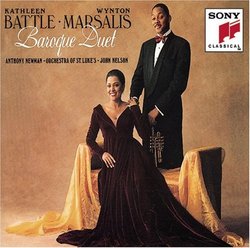 | George Frideric Handel, Alessandro Scarlatti, Luca Antonio Predieri Kathleen Battle · Wynton Marsalis ~ Baroque Duet / Anthony Newman · Orch St. Luke's · Nelson Genres: Pop, Classical
![header=[] body=[This CD is available to be requested as disc only.]](/images/attributes/disc.png?v=430e6b0a) ![header=[] body=[This CD is available to be requested with the disc and back insert.]](/images/attributes/disc_back.png?v=430e6b0a) ![header=[] body=[This CD is available to be requested with the disc and front insert.]](/images/attributes/disc_front.png?v=430e6b0a) ![header=[] body=[This CD is available to be requested with the disc, front and back inserts.]](/images/attributes/disc_front_back.png?v=430e6b0a) |
Larger Image |
CD DetailsSimilarly Requested CDs
|
CD ReviewsExperence the passionate baroque soul. Eric McCalla | 12/07/1998 (5 out of 5 stars) "Jazz buffs are very familiar with Wynton Marsalis and his trumpet. Opera lovers know the quality voice of lyrical soprano Kathleen Battle. A perfect blending of these two performers, in the Baroque music, has been acheived in this CD. The match of human voice and trumpet seems to us, at the end of the Twenth Century, a mismatch. But to quote Ellen T. Harris, who wrote the liner notes, "The real and sympolic power of the trumpet makes its combination with the quieter instruments and voice seems, at first, imbrobable, but a softer sweeter style of playing in the high ("clarino") register was typical in art music for the trumpet...". Sounds simple enough, but Wynton is one of the few players who can do it well. So well in fact, that at several points Kathleen's voice and Wynton's trumpet blend into one voice, a balanced singularity, even duplicating each others vibrato exactly. A truely amazing accomplishment, which can only be fully appreciated by listening; but once you hear this glorious sound, you'll want to upgrade your stero system to capture its fullness.Everyone I have had listen to this CD, and I've given away several as gifts, has come from the experience, with a changed paradigm, toward that "old" Baroque music. This recording presents the eras music in its true light - rich, with debth and color; and in my opinion, is more powerful than the passionate Romantics.I asked myself, "how can such a feeling of freedom be realized in an archaic, regimented, nay strait-jacket format?" The answer is in the musicans and how they make the music live.A word about those liner notes, which we seem to never appreciate anough, in this case they are very good. Ellen gives us very good background information on the composers, the principal musicians, the text (with English translations where appropriate), the track listings and playing times, and the list is printed on the CD. The only information missing is that concerning the conductor and the orchestra.Though to period purists this CD is marginal,it is only because period instruments are not used. The engineering, editing, and acoustics are all excellant.In addition, some of the composers are revealed in all their humanity. As in the case of Alessandro Stradella..."was involved in an embezzlement scheme against the Catholic Church and in 1677 avoided assination as a result of an affair, was murdered in 1682 as a result of another affair." Makes you curious what kind of music a Casanova would write.Track Notes: 1. George F. Handel-Let the Bright Seraphim Text in English. Kathleen on tone through out.(Most vocalists tend to flatten those really high notes, but not Kathleen-not once!) Good distinct sound between all the instruments. Kathleen has crisp pronunciation and diction.2. Alessandro Scarlatti-4 Arias from 7 Arias with solo trumpet. Tracks 2-5. Text in Italian. (Aria#1)Let the Trumpet Sound. Wynton is excellent at playing his own trumpet echo, at reduced volume, yet he is just as precise in his sound. Good blending of voice, strings, and trumpet. Kathleen has vibrato on her high notes that are just the right speed, which is what you'd expect from her.3. With Festive Voice (Aria #3). In Italian. Playing this presto tempo piece was smooth and steady through out. Kathleen's Italian is melted in the music, as any good Italian singer would do, yet her pronunciation is crisp. You can feel the fun the performers are having with this music; even though the fast tempo has the potential of bogging down during the tough bits, the players stays sharp. "The flowing 12/8 meter affords continual opportunity for voice and trumpet to alternate and overlap in waves of sound."4. She Breaks, She Scorns (Aria #4). In Italian. This one begins in a Major key at an allegro tempo with Kathleen rolling her 'r's and trilling her high notes followed by Wynton in an echo pattern. This piece is so short and is my only disappointment, with reguards to the composer's length not this presentation. One would think that maybe all these pieces would sound the same but that isn't the case.5. My Love I Die for Thee (Aria #6). In Italian. This aria uses an adagio tempo in major key with the harpsichord continuo very clearly heard as, contrasted with the old 'LP' days when continuo was never heard. Wynton exhibits his breath controll by trilling on the high notes just when you think he'd run out of air and I found myself taking in air for him.6. Alessandro Scarlatti- On the Tiber's Banks (no relation to the earlier mentioned Alessandro Stradella's Vatican embezzlement scheme). Tracks 6-13. In Italian. Sinfonia, without voices, is the introduction to this work. The chorus for this work is not presented. Only the soprano.7. Recitative - is sung by Kathleen and accompanied by the continuo instruments (ie., cello and harpsichord).8. Sinfonia - in this part, Kathleen almost runs out of air in a couple of spots but has that extra punch to just make it. At the end, she leads the trumpet in alternating the solo line and intertwining the sound into a duet unison, most lovely.9. Recitative - the second, as the first (track 7)the voice is accompanied by the continuo and at the largo tempo allows us the opportunity to listen to longer singing lines for all instruments, which flows directly into the next movement.10. Largo - maintaining the former tempo but shifting to a minor key, which begins simply with violin, then viola, and then cello each brought in to play measure by measure (no trumpet) and transitons into major key at the end. "The trumpet plays the melody before and after the singer, transforming her song into a plantive wordless cry." One of the best sensual movements Scarlatti wrote.11. Aria - back into the minor key at a bit faster tempo with her voice and strings repeating each other into the ... Ritornello - at adagio tempo, orchestra only; very brief, then directly into...12. Recitative - again voice and continuo in minor key, which breaks into major key and allegro tempo lead by the trumpet, most effective on the composers part because it leads into Kathleen's next...13. Aria - which symbolizes the triumph of good over evil and concludes with a repeat of the original sinfonia (track6).14. G.F. Handel - Eternal Source. In English. From the Ode to Queen Anne on Her Birthday. Largo tempo in major key. If you are only familar with Handel's Messiah, get ready to have the most lush, full music ever written to delight your sences. This is the track for the long, souring singing lines for all the instruments, but especially for Kathleen, whose lines are followed by the trumpet. Handel is the only major composer, who's English texts I like put to music. Every other composer I've heard fall so far short when compared to him.15. Luca Antonio Predieri - Peace Just Once. From Zenobia (1740). In Italian. Adagio tempo in major key transposing to minor key and back to major. Trumpet and orchestra lead out, followed by the voice, which again comes so close to not having enough breath but I think this is the fault of the composer. (After all Stradella wasn't the only ladies man and what a cleaver way to be the hero by helping the lady in distress, who was trying to sing his music and hyperventilating, and needed a rest in his chambers.) Kathleen has amazing voice control on the coloratura and with very high finishes with lots of trills on the trumpet's peak parts. Voice and trumpet blending in unision and you cannot discern either one distinctly. Well done.16. Alessandro Stradella - Sinfonia to the Serenade Il barcheggio (1681). Tracks 16-19. Trumpet and orchestra, no vocal part. Adagio tempo in major key.17. Allegro tempo in minor key.18. Allegro tempo in major key.19. Gavotte tempo in major key. Trumpet leads the orchestra with the main musical theme in unison and/or harmony. Great inner support between soloist and group.20. J.S. Bach - Sighs, Tears, Grief, Misery from Cantata No. 21 Endured Much Misery. In German. With all that you can guess that this is a sad number and it's taken at Largo tempo and of course minor key. The trumpet and organ start with the voice following one third lower. What a great language to express this music. Wynton did an amaziong cover of an error by turning it into a two note trill - what a great save. I wish I could save my off notes that well.21. G.F. Handel - To the Bronze Warrior's Voices from Cantata No.19 Oh! How Bright and Beautiful. This is my favorite track because you can hear Kathleen working her voice placement around to different parts of her mouth for a marvelous effect. Her voice is the musical statement echoed by the trumpet and the two weave around each other ending up in unison at the top notes, spintingling is possible, all with solid orchestra support. Handel did most of his stuff in English, though he originally went to England to write Italian opera. This piece shows he did indeed know how to do just that.22. J.S. Bach - Rejoyce in the Lord All Ye Lands from the Cantata No.51 Tracks 22-23. In German. Aria - My favorite Bach cantata is this" Baroque duet...baroque perfection! Eric McCalla | Denver, COLORADO | 04/10/2001 (5 out of 5 stars) "I had been a huge fan of both Kathleen Battle and Wynton Marsalis for many years, when I had the good fortune to see a PBS tv documentary on the making of this album. I was playing this album literally 3-4 times daily, so it was a delight to see the artistry and passion they brought to the recording. Not only do you see the artists working with great joy and humor in the studio, you also get to see Kathleen Battle give a recital concert in her hometown church in Ohio, singing the roof off! Talk about a homecoming....The album opens with a technically stunning rendition of Handel's LET THE BRIGHT SERAPHIM, which displays Battle's great coloratura. Wynton Marsalis is a gorgeous match for her silvery top notes and crystal-clear diction. She is unmatched in her ability to bring out every glorious syllable. The most beatiful piece on the entire album, and it's not easy to choose just one, has to be ETERNAL SOURCE OF LIGHT. You will literally think you're surrounded by celestial light, her singing is that gorgeous. Again, Marsalis' trumpet is perfectly matched to her voice. They really outdo themselves in the Scarlatti material; especially in the 7 arie con tromba sola (my favorites being SI SUONI LA TROMBA and MIO TESORO PER TE MORO) and SU LE SPONDE DEL TEBRO, which features gorgeous harpsichord....Stupenda.It would be truly amazing if Battle and Marsalis would collaborate again. This is one of the most beautiful duet albums in any genre you'll ever hear. Bravo!!!!" Baroque Perfection M. Ramos | 11/24/2000 (5 out of 5 stars) "It is difficult to express in words the experience of hearing Kathleen Battle and Wynton Marsalis perform this brilliant and difficult pieces on this recording. Every single number on this recital of Baroque pieces for voice and trumpet is a wonder of energy and technical precision. Kathleen Battle's silvery voice is particularly fond of the Baroque repertoire. The extremely difficult arias and cantatas of this CD suit Battle's voice perfectly. The soprano shines with nimble coloratura, soaring high notes (up to brilliant C's and D's)and precise control of dynamics. Marsalis is a perfect partner for Battle, a true virtuoso capable of establishing an effective rapport with the vocal line. The ornamentation used by both artists is both tasteful and brilliant, always mindful that this music calls for both display and ensemble work. John Nelson, an accomplished Baroque conductor, conducts with his usual mastery the Orchestra of St. Luke's, an ensemble who brings excellent support to the work of the soloists. Among the highlights of the recording are Let the Bright Seraphim, with the brilliant trills of both Battle and Marsalis, the fours arias from Scarlatti's Arie con Tromba Sola, and above all, the two movements from Bach's Cantata No. 51 that close the program. These are perhaps the best interpretations of this cantata movements I have ever heard. An unique recording that proves what the term "virtuoso" really means. Highly recommended."
|

 Track Listings (23) - Disc #1
Track Listings (23) - Disc #1

